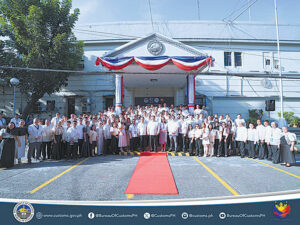For the past 123 years, the Bureau of Customs (BoC) has been the Philippines’ standard of excellence in enhancing trade facilitation, strengthening border control, and improving the collection of lawful revenues. Its milestones and history show its strong commitment to economic growth, security, and modernization, constantly evolving to keep up with global trade while staying true to its mission of serving the Filipino people.
One of the bureau’s biggest achievements is its survival from pre-colonial times up to the present. According to the BoC’s website, even before the Spanish came to the Philippines’ shores, datus or rajahs collected tributes from the people before they were allowed to engage in their trade. These were then observed and followed as the Customs Law of the Land.
Meanwhile, three key trade laws defined customs policies during Spanish rule in the Philippines: the Spanish Customs Law (1582-1828) imposing ad valorem duties, a Tariff Board setting fixed import values with a 10% duty, and the 1891 Tariff Law introducing specific duties on imports and certain exports until Spanish rule ended. Under American rule, the Spanish Tariff Code of 1891 remained until the Tariff Revision Law of 1901. Key reforms reorganized customs positions and laws, and the Philippine Customs Service evolved into what we now know as the Bureau of Customs under the Department of Finance (DoF).
From the Commonwealth era to the present, the Bureau of Customs underwent multiple reorganizations, including the separation of immigration authorities; the creation of the Tariff and Customs Code; structural changes under Martial Law; alignment with international customs standards; and modernization efforts like the establishment of the Management Information System and Technology Group (MISTG).
Through these transformations, the Bureau of Customs has achieved significant progress in revenue collection, trade facilitation, and border security that has stood the test of time and still ensures that it remains a key driver of the country’s economic stability.
The latest annual numbers from the BoC indicate that it collected a record-breaking P883.624 billion in 2023 — a 2.46% increase from the previous year. While data from 2024 is still unavailable, bureau collection from January to October of the year reached P784.54 billion, marking a robust 6% increase compared to the same period last year.
The bureau’s strong performance in 2023 and subsequently in 2024 underscores its commitment to continued effectiveness in driving revenue generation, which plays a crucial role in funding government projects and services for the Filipino people. The BoC’s revenue comes from payments collected for customs duties, indirect taxes, and other levies at ports of entry across seaports and airports in the Philippines.
In a bid to keep up with the times, the Bureau of Customs underwent a massive endeavor to modernize its customs administration to be at par with global standards through the Philippine Customs Modernization Program (PCMP) with the support provided by the World Bank Group. The PCMP aims to streamline operations and processes and support the reform agenda by upgrading BoC systems, procedures, and operational activities.
The BoC opened 2025 with its annual New Year’s Call, held on Jan. 6.
Among these initiatives is the Customs Processing System (CPS), which serves as one single and unified system that combines all the key elements and customs procedures; organizational modernization, which ensures that the institutional structure responds to new responsibilities; and the utilization of Remote Image Analysis Centers (RIAC), which allows BoC to receive and interpret radioscopic images sent from operational scanner sites in real-time.
So far, the DoF reports that the BoC has digitalized 160 out of 166 customs processes, a 96.99% digitalization rate, with one system launched for operation, two systems ready for implementation, and three systems being developed for efficient customs services.
Thanks to the BoC’s push for simpler processes and smoother trade, the Philippines made a big leap in the World Bank’s Logistics Performance Index (LPI), jumping 17 spots to rank 43rd out of 139 countries from 2022 to 2023. The LPI is a tool designed to help countries assess their trade logistics performance, spot challenges and opportunities, and find ways to improve their efficiency in moving goods.
43rd is the country’s highest ranking in the logistics report since 2007. In Southeast Asia, the Philippines’ ranking only lags behind Thailand (34th), Malaysia (26th) and Singapore (1st). In addition, the ranking showed that the country tied with Vietnam and had better logistics performance than Indonesia (61st) and Cambodia (115th), based on the LPI.
Significant milestones have also been realized by the BoC in preventing the smuggling of goods to and from the country. In 2024 alone, the bureau seized a record-breaking P85.167 billion worth of smuggled goods which highlights the BoC’s anti-smuggling efforts, continued vigilance, and commitment to safeguarding the nation’s economy and ensuring that only legitimate goods enter the market.
As the BoC continues to build on its past successes, its focus now shifts toward an even better 2025. Annually, the bureau releases its Five-Point Priority Program (5-PPP), aimed at driving efficiency, boosting revenues, and safeguarding trade. For this year, the BoC is looking to strengthen its role as a pillar of the Philippines’ economic growth and security while meeting the evolving demands of international trade.
Fully automating its systems, which, as mentioned earlier in the article, stands at 96.99%, figures to be the bureau’s top priority this year as it will enhance operational efficiency and transparency while minimizing corruption risks. The customs agency is also committed in surpassing its revenue target and has set an ambitious goal of generating P1.06 trillion in revenue in 2025.
Streamlining its processes in line with international best practices is also an area where the BoC is looking to improve as it aims to simplify procedures to facilitate legitimate trade while ensuring security. Curbing smuggling to protect the nation’s borders and economic interests, as well as dedicating significant resources to improving employee welfare and professional development, are also included in the bureau’s priority program.
As it celebrates its 123rd anniversary, the Bureau of Customs stands as a testament to resilience, transformation, and commitment to its mission. With the bureau’s constant dedication to improving its services to the Filipino people, the Philippines is slowly becoming the world-class, modernized, and credible customs administration that it aspires to be. — Jomarc Angelo M. Corpuz

